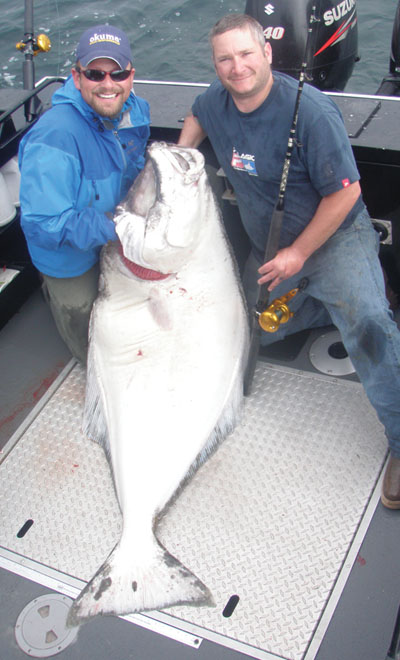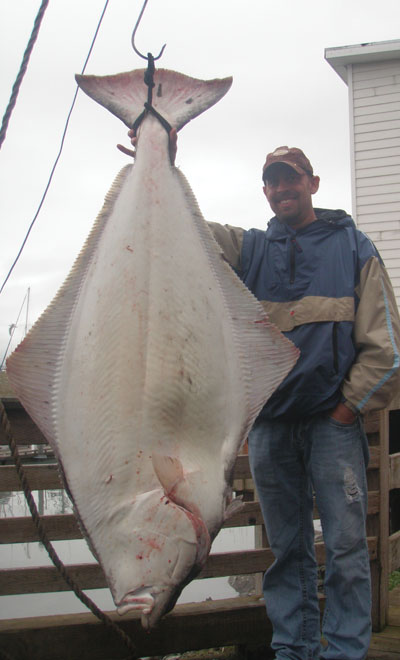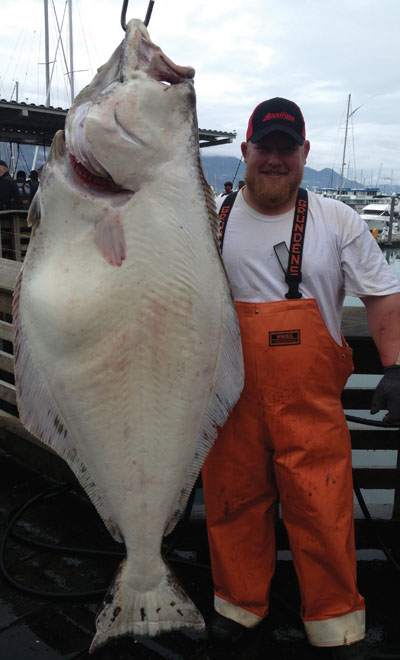There are many factors to consider when it comes to catching trophy halibut, including the tides, choice of bait, size of baits, structure, depth and tackle. However, here I will focus on bait scents and my use of a Halibut Scent Bomb of personal design.
The Timely Use of a Halibut Scent Bomb & Big Baits
 Story and photos by Captain Randy Wells
Story and photos by Captain Randy Wells
As way of background, I have been running a six-pack charter boat out of Seward since 2007 and I chase halibut close to 100 days per year, so this is information I’d consider both hard-earned and accurate. [emember_protected custom_msg=’This content is available for subscribers only.’]
First, let’s be clear on terminology: smaller halibut under 25 pounds are referred to as “chickens.” Chickens usually swim in large schools and rarely leave a particular area, what we refer to as a chicken patch. Turkeys are halibut from 30- to 80 pounds. Turkeys are found in smaller schools than chickens, but in larger schools than the huge trophy halibut. Trophy halibut are fish over 100 pounds; these monsters are found in small groups, typically anything from a single to 7 fish. This is not to say I never catch chickens where I catch trophy halibut, or vice versa. However, in my years as a charter boat owner/operator out of Seward, I have found that more often than not these groups don’t mix. So, before you plan a trip to Alaska for halibut, or prior to leaving the dock with your personal boat, know what your target is—chickens, turkeys or trophy halibut—and remember different areas produce different fish.
For many folks halibut fishing in Oregon and Washington, these 100-pound-plus fish are rare, but that doesn’t mean you should just go out and be content with 25- to 35-pound fish. There are lots of turkey-sized halibut in Oregon and Washington, so if you are interested in bringing in 60- to 80-pounders instead of a deck full of chickens, listen up. These techniques will work everywhere for halibut. With that said, let’s go through a day fishing on my charter boat, the Rogue. We’ll be chasing big halibut out of Seward.
Before I head out to chase big ’buts, I make sure the boat and tackle are ready. I stock the boat with plenty of fresh bait; I usually have 75 pounds of black label herring (remember I fish 6 anglers per day), a few gallons of assorted Pro-Cure bait oils, and their new water-soluble scents. Pro-Cure makes a Deadly Dunkin’ Scent Bomb in a 4-ounce bottle, and I liked it so much for salmon and steelhead I got them to make it for me in a half-gallon size. Basically, it is a water-soluble Super Gel, and I have had great luck with it bringing in big halibut on otherwise tough days. I also take a few pounds of fish scraps from the fillet tables from the previous day’s catch. Be sure your bait is fresh. Although halibut cruise right along the bottom they are not trash feeders. Rotten, stale or foul-smelling bait will not work, especially for the larger fish.
Proper tackle is a must when targeting huge halibut. Leave the light tackle at home and step up to much heavier gear. My favorite rod for these huge fish is a Lamiglas BFC 5610 rod with roller guides. For reels, my favorite is an Accurate Boss reel, loaded with 80-pound TUF-Line. For leader I use Berkley 40-pound mono, with a Mustad circle hook. I’ll also run a stinger hook to hold large baits in place if fishing whole salmon carcasses.
While heading out to the trophy halibut waters, my deckhand and son, Logan, spends his time getting ready for the workday. Logan starts by getting the bait ready. He puts 20 pounds of herring in a 5-gallon bucket, then adding 3 cups of Pro-Cure oil and two gallons of water from the Gulf of Alaska. (Do not use water from your harbor, as it can be contaminated with rancid bilge water,
fuel, etc.)
If your herring is soft from being thawed out for a couple days, add some Pro-Cure Brine-N-Bite Bait Brine powder to your baits the night before. The Brine-N-Bite will not only firm up your baits, it will infuse your baits with bite stimulants that halibut seem to really like.
Many times the halibut grounds can cover acres, or even square miles, and all of it is not the same. Over the years top anglers have targeted big ’buts in channels, or areas with sandy versus rocky bottoms, or a sandy shelf, and other types of structure. Structure that holds baitfish is my favorite when looking for big halibut.
When fishing for trophy halibut from anchor, your anchor placement is key. Know where your stern is pointing in reference to the structure. The first thing I do is judge the speed of the current, estimating time and duration of the slack tide before I drop my anchor. After dropping your anchor, if your boat does not end up where you want it, pull it and drop it again. Don’t settle for missing the sweet spot. If you know the hotspot, it’s worth the frustration to drop and pull your anchor two or three times to finally get it right.
I usually have 6 clients on board so we bait and fish 6 rods. A few of the bait rigs I use on individual leaders are: Three black label herring on one rod, a whole pink salmon or Pacific cod (where allowed) on one rod, and fresh octopus tentacles with two whole herring on the other two rods; finally, a single black label herring fishes on the last rod. My personal favorite halibut bait is a rod rigged with a Kalin’s 10-inch Big ’N Grub. My favorite jig colors are white, black and orange. I always use the Pro-Cure Super Gels on my jigs. Many times I will also tip my jigs with a piece of herring, squid or octopus, as quite often a jigging rod will out-fish bait. I’m sure it’s the sudden movement that triggers the bite, but I have noticed by adding the super gel to my jigs that I get more strikes, bigger fish, and if they miss hooking up on the scented jig, those halibut come back and hit it again. Without the use of scent a missed bite is a lost fish.
Be sure to inject your baits with scent before sending them down. This is so critical. I use a lot of scent when chasing halibut of any size, but the big ones are big-time scent feeders. They will come in from a long way off if the scent is one they like. Just like bloodhounds, they will follow your scent right to your baits. I really don’t want to sound like a Pro-Cure commercial, but I’ve been doing this for many years and I have consistently had my best success using the Pro-Cure bait oils and scents. I mix the Pro-Cure bait oil with their new water-soluble fish oils and inject it into each bait. You want your baits leaking scent. Halibut are a scent-attracted fish; herring oil, squid oil and Pro-Cure Butt Juice are my go-to scents. Once the baits are down you will begin to create a scent trail.
Sometimes you drop down and hit a school of halibut right on their noses and it’s instant hookups with 2- to 4 rods buckled down. Other times the schools of halibut are a ways off, and it will take some time for them to pick up your scent trail and follow it up to your baits.
Some anglers like to use a chum bag on their anchor. I have found this to be a problem at times. For example, you could bring the fish to your anchor, which is 200- to 500 feet in front of your bow, while your baits are 100- to 300 feet past your stern. Many times big fish swim right past your baits, following the scent trail right up to your anchor. I prefer to bring the fish to my baits, and I do this by using scent/chum bombs.
Timing the tide with your scent bombs is crucial. If you send your scent bomb down during the peak of a ripping tide, your scent will be gone before it does its job. So instead of sending down a scent/chum bomb during the heavy tidal flow I just make sure all of my baited hooks are giving off plenty of scent. I have my clients reel their baits up every 15- to 20 minutes to re-inject oils into those baits, and then they get them right back down.

Continue to send these scent bombs down through the entire slack-tide cycle. Once the tide starts to flow again, it will create a massive scent trail, and those trophy ’buts will come right to you. I cannot tell you how many times I have caught a trophy halibut just after dropping a scent bomb. Something about this technique drives these monster fish crazy.
A final piece of advice and one I give on a daily occurrence aboard the Rogue. When a halibut starts to bite, don’t touch anything. Just wait, wait and wait! Wait for that rod to buckle over and for line to be peeling off your reel. Once your rod is buried and line is peeling off, put your reel in gear and reel, reel, reel! If you are using large circle hooks it is critical to just reel and to not set the hook. If you try to set when using a circle hook you will pull the hook right out of a fish’s mouth. Here is how a circle hook works: the fish actually swallows your bait down its throat and often into its stomach. When you reel, and only reel, you will pull the hook up the fish’s throat, and as the line passes over the fish’s mouth the circle hook will bury under the fish’s jaw, creating a positive hookup. This will not happen if you try to set the hook with your rod. If you are using a standard J hook, then setting the hook will work, but with a circle hook you never set the hook, just reel.
So now you have a trophy halibut to the boat; it is clearly over 150 pounds and you have a decision to make: keep or release. If you are using a circle hook, you can release this fish unharmed to fight another day, but do you want to?
The fact is that most halibut over 50 pounds are female, and these females are not as abundant as many people think. Moreover, most halibut over 100 pounds do not eat as well as smaller fish. When targeting trophy halibut, I always inform my clients of these facts. My thought is a trophy halibut is best left to breed. However, if this is a fish of a lifetime, it is up to the angler where that fish ends up, be it back in the water or in the freezer. For all the big halibut photos I have, there have been at least an equal number of fish released to fight again. Just remember, if you plan on releasing a halibut, do not harpoon it, and never pull it out of the water into your boat. Just tire the fish until it is lying on top right next to the boat. Then snap a few quick photos and either work the hook out of its jaw, or cut your leader as close to the hook as possible and let your big fish swim back down to make more little halibut. The future of our fisheries depends on our stewardship.
###
Randy Wells of Fish Seward Alaska, Inc., is a full time guide/charter operator in both Alaska and Oregon. He can be reached through his website at www.fishsewardalaska.com. [/emember_protected] [emember_protected scope=”not_logged_in_users_only”]
- Need to subscribe? Now’s a good time! Check out our current subscription specials!
- Already a subscriber? Login below to access all of our online articles and content!


